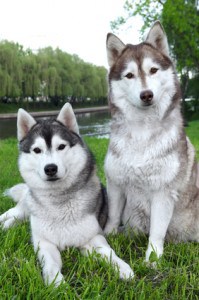The Alaskan Malamute temperament is loyal, intelligent and Independent. This cuddly big dog adores his master and is friendly with people in general.
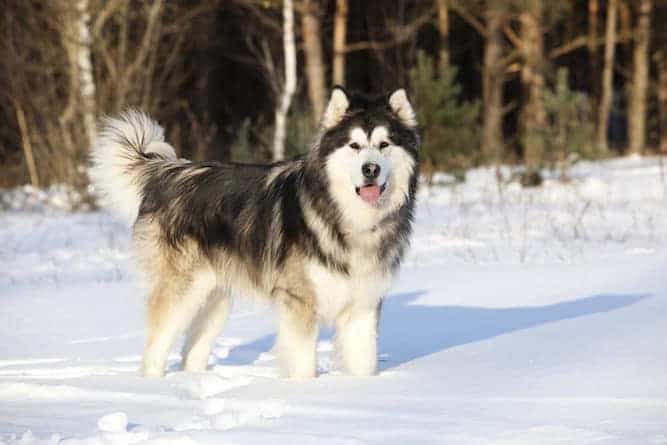
If you have older children, the playful Alaskan Malamute temperament may well suit your family. However, even as a puppy, his bouncy nature and his rapidly increasing size can cause problems. For example, he can easily injure small children and elderly people, purely because he is enthusiastic to see them.
If your dog is well raised and trained, he will mature into a gentle and laid back companion.
So while the affectionate Alaskan Malamute temperament sounds like it makes him the ideal family pet, don't be too quick to choose this breed.
There are some things about the dog's temperament that you must know before you bring that gorgeous fluffy puppy home.
Challenging Aspects of the Alaskan Malamute Temperament
Intelligence and Independence
The Malamute is a very independent dog and likes to be the boss. He can be difficult to train, and therefore not really suited to new dog owners.
The ideal handler for this type of dog temperament is someone who is experienced with dogs, and who can act as a fair and consistent leader of the family pack.
In spite of the difficulty, it's important that you do teach your Alaskan Malamute good manners from the day you bring him home.
We are all tempted to let a cute puppy get away with things, but it won't be so cute when he is a mature adult with a mind of his own. Start as you mean to finish and you'll be able to better manage your dog's temperament.
Animal Aggression
The most frightening part of any dog's temperament is aggression, and unfortunately, this can be a problem in the Alaskan Malamute.
While they are very reliable with people, they can't be trusted with other animals.
Many Malamutes are so aggressive with a canine companion that you can't house him with another dog of the same sex.
Some won't put up with the opposite gender either. They are often best suited to an only-dog household to prevent dangerous fighting.
Prey Drive
This breed is also very predatory with small animals such as cats and rabbits. If it runs, he will chase.
Some Malamutes have been well socialized with other pets and they can live harmoniously with other species, but you should never be complacent.
Always supervise your Malamute when there are other animals around.
Food Aggression
Give your Malamute some space at mealtimes. He is very possessive of his food and will become aggressive if he fears it is going to be taken away from him. Click here to learn how to stop dog food aggression.
Alaskan Malamute Temperament Demands Activity
The Malamute is not a breed for a couch potato. He needs activity and lots of it.
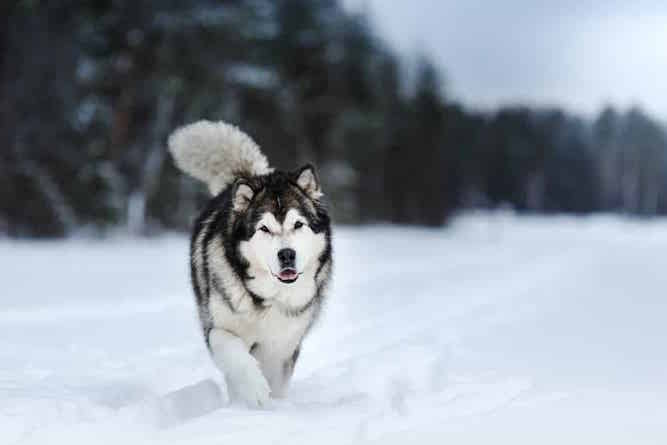
This dog was bred to haul a sled over ice for several hundred miles, and he has astounding endurance.
This can be a burden on his owner – the Malamute needs an hour or more of exercise each day to be happy. He won't be content with being a stay at home pet without the opportunity to expend his energy.
If you decide to adopt a Malamute, then be prepared to walk him for miles. Take him hiking or rollerblading to tire him out. The best thing to do would be to join a sledding club and let him do what he was bred to do.
By doing so, you reduce the chances of boredom-related behavior problems such as digging and howling. In fact, if your Malamute is misbehaving you might be pleasantly surprised to see what exercise can do for his behavior problems.
Howling
You can expect your Alaskan Malamute to howl when he is bored, or when he is left alone for too long. This won't endear you to your neighbors!
This is typical of the sled dog temperament and can be prevented by giving him enough exercise and training.
Do not confuse this specific reaction with dog separation anxiety which is itself a different and difficult challenge.
If you go out often, then you will need to lock your Malamute away to dampen the noise. Or better yet, don't get a Malamute if you can't devote the time that it requires.
Your Canine Escape Artist
The Malamute's independent streak can lead him to escape his yard and go exploring around his neighborhood.
This can lead to him being hit by a car or becoming involved in a dog fight. Your dog needs sturdy 6-foot fences around his property to stop him getting out.
A Brief History of the Alaskan Malamute
The origin of the Alaskan Malamute began as a loyal human companion and this continues to today.
The Malamute would help with everything from hunting to working and even just being a live-in friend. Hunters used the large dog to hunt large prey, like bears and seals.
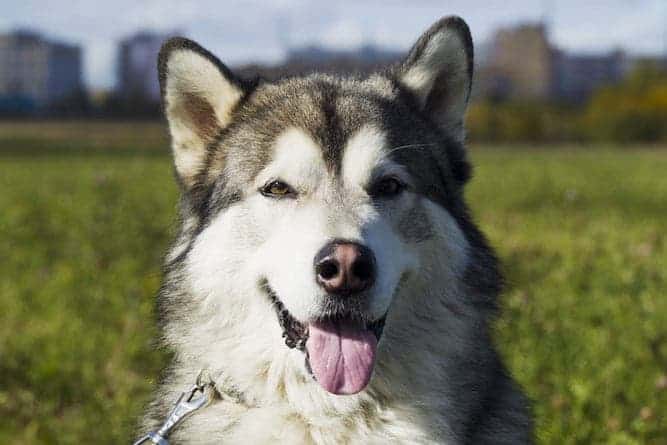
The breed almost became extinct during the Second World War, with 30 Alaskan Malamutes left in 1947.
A lot of people compare the dignified Alaskan Malamute temperament to that of the Siberian Husky, which makes sense. Though, while they may look similar, the two breeds differ greatly from each other.
For instance, while the Husky may be smarter than the Malamute, the Malamute has a larger, stronger body that can better handle tougher work.
Alaskan Malamute Training
When it comes to training, Malamutes are intelligent, which allows them to learn faster. However, that intelligence can turn to stubbornness rather quickly.
You must socialize and train him as early as possible to prevent him from thinking he can walk all over you. Establish early on that you are the leader, and he will learn to respect you.
One thing you must know is that there are some behaviors you simply can’t train a Malamute to stop. He may always be a digger, no matter what you do, for example. So make sure your fence extends into the ground, or he will dig his way right under it and out of the yard.
Helpful Dog Training Resource:
For help with training your Alaskan Malamute
Alaskan Malamute Grooming
When it comes to Alaskan Malamute care, you definitely have your work cut out for you. I mean, just look at all that floof!
His coat is thick and waterproof to protect him from the elements. As such, you need to brush it every day to prevent mats and to keep him looking healthy.
He goes through a “shedding season” twice a year, and he needs a bath every six to eight weeks. You can also toss in a little conditioner if his coat feels too dry.
As far as Alaskan Malamute colors are concerned, no matter how you slice it, you're looking at a combination of some color and white. His color combinations with the white include seal, sable, brown, black, red, and gray.
One thing you should never do is attempt to shave your Alaskan Malamute. If you shave his coat the wrong way, it can permanently affect how it grows back.
If you feel you must shave your dog, bring him to a professional groomer who has the right tools and knows the right techniques.
Alaskan Malamute: Staying Healthy
Most Alaskan Malamutes are solid, healthy dogs, but this doesn't make them immune to the potential health issues that can affect the breed. Some of these conditions include:
- Hip dysplasia
- Elbow dysplasia
- Eye issues, like cataracts
- Bloat
- Thyroid disease
- Diseases that interfere with blood clotting
- Skin conditions
- Hair loss
On average, the Alaskan Malamute size ranges from 22 to 26 inches high. They also typically weigh between 71 and 95 lbs, so if you're looking for a big dog, this one's a doozy.
You can also track his growth with a growth chart if you're interested in seeing how much he will grow each year.
The Alaskan Malamute lifespan is between 10 and 12 years.
Important Note: Few things are more important than our Health. It's no different with our Dogs Health. Some visits (and Money) to your vet can be avoided if only you know what to do when your dog is ill. The Ultimate Guide to Dog Health is the answer. No dog owner should be without this handy guide. It's no substitute for your vet but it will Save you Money and Heartache. This Dog Health Guide will help you quickly understand and recognize symptoms before they become a serious problem for your dog. Click Here to see if you agree.
Finding the Perfect Alaskan Malamute Puppy
So, in double-checking that the loyal Alaskan Malamute temperament (along with all its challenges) is a perfect fit for your home, you have decided to add one to your family. Congratulations!
You can find an Alaskan Malamute for sale either from an Alaskan Malamute breeder or at your local animal shelter.
Alaskan Malamute Puppies for Sale
The average Alaskan Malamute price is between $1,200 and $1,700.
The price usually increases with the pedigree of the dog. It also depends on how much the breeder decides to charge.
Alaskan Malamute Rescue and Adoption
If you want to adopt an Alaskan Malamute puppy, you may be able to find one at your local animal shelter.
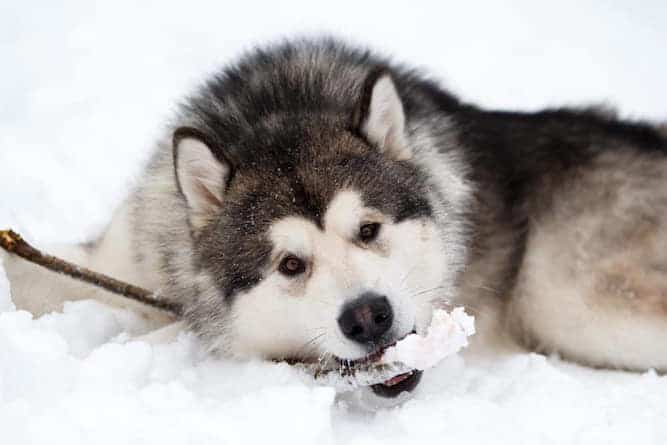
An Alaskan Malamute adoption is ideal if you have no interest in training a puppy, or dealing with the destruction one can cause. This is because most animals that end up at a shelter are already full-grown and possibly even trained.
And, of course, a deciding factor for many people is the price. If you can't afford $1,200 to buy a puppy from a breeder, then an adoption fee that costs hundreds less certainly sounds more appealing.
A shelter is also a great way to find an Alaskan Malamute mix, as fewer people are likely to give up a purebred than a mixed breed.
Alaskan Malamute Breeders
If you're in the market for an Alaskan Malamute and do not want to go the adoption route then an Alaskan Malamute breeder shouldn't be too hard to find.
A good resource to consult is the Alaskan Malamute Club of America. With official websites like this, you can rest assured that they wouldn't promote a breeder who didn't pass their required qualifications.
Regardless you want to spend sufficient time and conduct proper due diligence on a chosen breeder. Make sure you visit their property armed with many questions to ask. Observe their responses and their treatment and condition of puppies and parents.
Be prepared to walk away if you are unsatisfied. Otherwise, you might very well make a bad investment in your purchase of a poor quality Alaskan Malamute.
Other Working Dogs
The Alaskan Malamute belongs to the group of those breeds known to experts as the Working Dogs group. Experts group working dogs by their strong, large bodies, and by their ability to excel at tasks that include rescuing, pulling, and guarding.
These dogs are typically highly intelligent and resourceful, which makes them fast learners and great companions.
If, after reading about the Alaskan Malamute, you decide this is not the right breed for you, you may want to consider some of the other dogs who belong to the Working Dogs Group:
- Bullmastiff temperament
- Boxer temperament
- Akita temperament
- Great Dane temperament
- Great Pyrenees temperament
- Bernese Mountain dog temperament
Conclusion: Why the Alaskan Malamute?
The devoted Alaskan Malamute temperament makes him a cuddly ball of fluff. For this reason, a Malamute simply does not make a good guard dog.
He may intimidate people with his size, but if they know about the friendly Alaskan Malamute personality, they'll know he simply isn't wired to be protective. He's more of a hunter by nature than a protector.
He loves his people, but be careful introducing your Malamute to other animals. Other dogs, especially those of the same gender, may prompt a fight, and smaller animals may appear to be prey.
The best way to combat this is with early socialization and training – the earlier, the better.
While these attractive dogs are great with people and children, there are many characteristics that make them difficult to live with. The Alaskan Malamute temperament is really only suited to someone who knows how to train and manage these assertive animals.

Calvin is the co-founder and one of the main contributors to dogtemperament.com. He has been an avid dog lover all his life. He enjoys researching and sharing great ideas on how you can avoid common pitfalls of dog ownership and build the most loving and enjoyable relationship with your dog.

